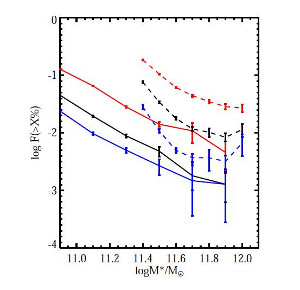|
|  |
In a recent paper, scientists from an international collaboration
consisting of the MPA , the University of Wisconsin and Johns Hopkins
University, as well as other members of the BOSS team, studied the masses
and ages of around 300,000 massive galaxies at redshifts ranging from
0.45 to 0.7, corresponding to a time when the Universe was 60 percent of its
present age. These galaxies all have stellar masses larger than 100
billion suns (1011 Msun), making this the largest sample of
massive galaxies with spectra to have been analyzed thus far.
Massive galaxies are very interesting to cosmologists, because they are
thought to represent the end point of galaxy evolution. The now standard
Lambda-Cold Dark Matter paradigm provides detailed predictions for how
structure in the dark matter component of the Universe assembles over
time. In short, structure formation is a "bottom-up" process, with the
smallest dark matter halos collapsing first, and then merging to form
larger and larger systems such as groups and giant clusters of galaxies.
For a long period, these cosmological predictions came under attack
by many observers, because the most massive galaxies that were known
appeared to consist only of extremely old stars. How could this be
consistent with a scenario in which the most massive structures formed
last? As telescopes grew more powerful, observers were able to survey
faint galaxies in the very distant Universe, where light travel times
become comparable to the age of the Universe itself. The observers found
that the number of massive galaxies present at early cosmic epochs was
indeed far less than the number present today, confirming that massive
galaxies assembled rather recently. However, they also found that
the most massive galaxies in the early Universe were apparently still
composed of relatively evolved stars -- in other words, no matter how
far back in time observers looked, they found little evidence for recent
star formation once a galaxy reached a certain threshold in stellar mass.
These results caused much consternation among theoreticians,
who calculated that large quantities of gas should be cooling and
forming stars in the dark matter halos surrounding massive galaxies.
As a result, there has been much debate and speculation about exotic
mechanisms that heat the gas and prevent it from forming stars. Examples
range from giant explosions powered by material accreting onto central
black holes of a billion or more solar masses, to Megaparsec-scale jets
of charged particles traveling at relativistic speeds, which penetrate
and heat the gas surrounding the galaxies.
The new results from SDSS-III indicate that these exotic mechanisms may
have a much harder time stopping star formation in massive galaxies at
higher redshifts. The MPA/Wisconsin/JHU team employed a technique that
could estimate the age of the stars in a galaxy using detailed stellar
absorption line features in their spectra. In massive galaxies, the
youngest stars are often shrouded in cocoons of dusty gas that absorb
much of the blue light emitted by young hot stars, so inferences based
on galaxy colour can lead to wrong answers. The new technique and the
unprecedentedly large galaxy sample, allowed the team to conclude that
the fraction of the most massive galaxies with young stars has decreased
by a factor of 10 over the last 4 billion years (see Figure 3).
At redshift 0.5, more than 10% of all galaxies with stellar masses
of around 200 billion solar masses have experienced a significant
recent episode of star formation. These
results are at odds with claims from some observers that the stars in
massive galaxies all formed 2-3 billion years after the Big Bang. The
results are also exciting, because next generation X-ray satellites will
be able to detect the gas as it cools and forms stars in these massive
galaxies and next generation radio surveys will track how energetic
particles propelled by black holes deposit their energy into this gas.
Current speculation about exotic mechanisms will then be transformed
into hard science.
Guinevere Kauffmann
Publication:
 http://arxiv.org/abs/1108.4719 http://arxiv.org/abs/1108.4719
Further Links:
 BOSS BOSS
 SDSS-III SDSS-III
|


